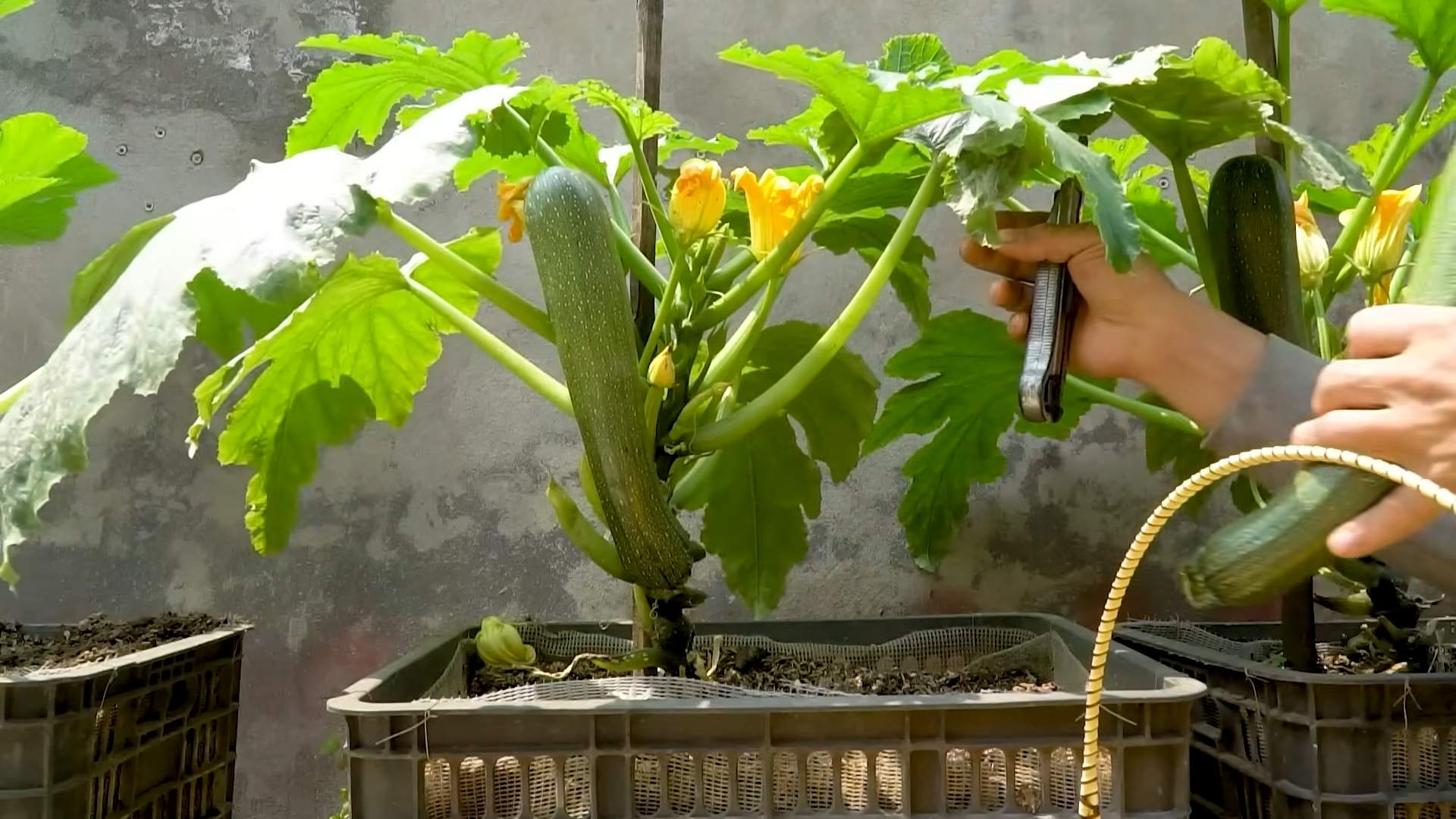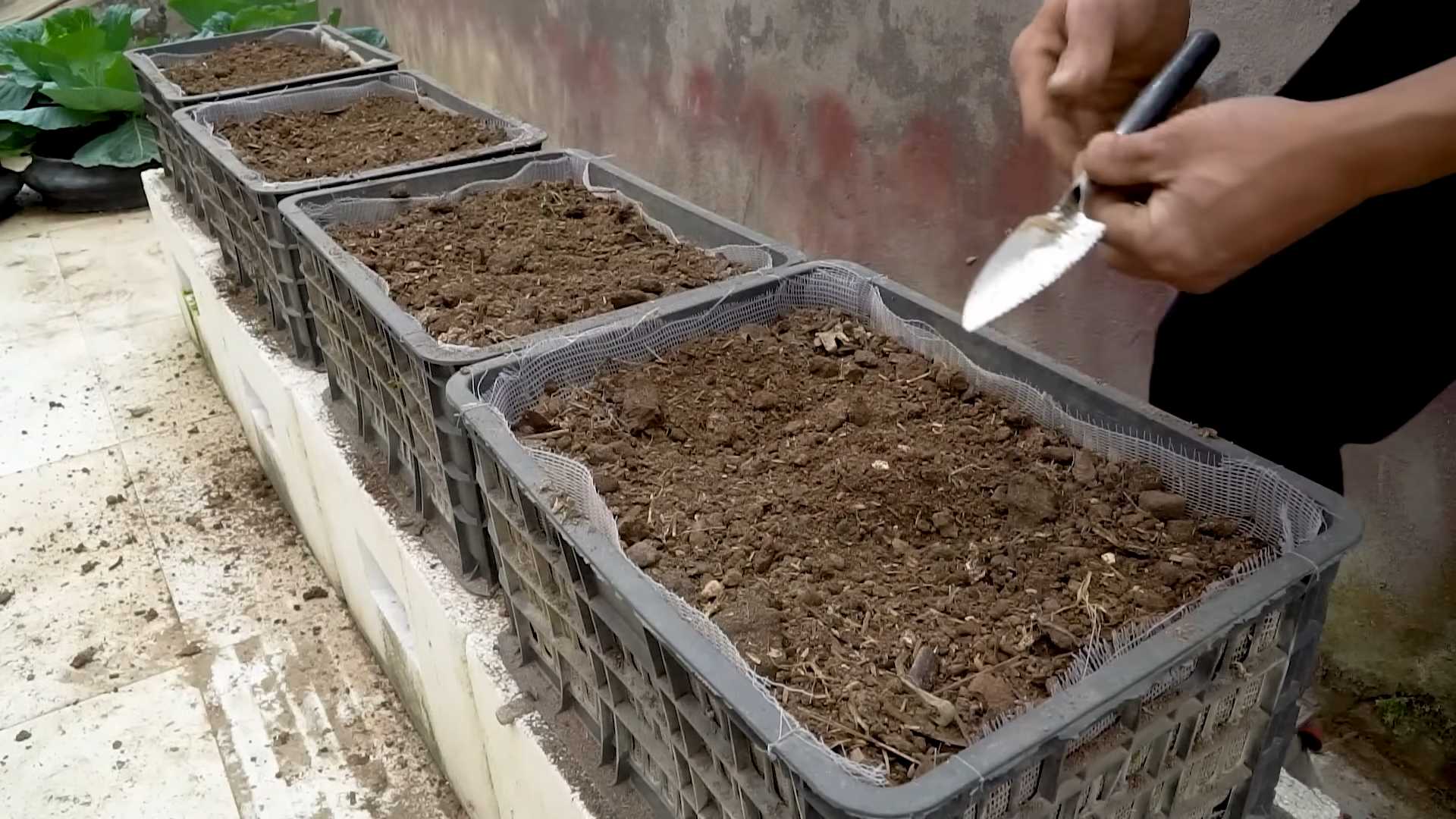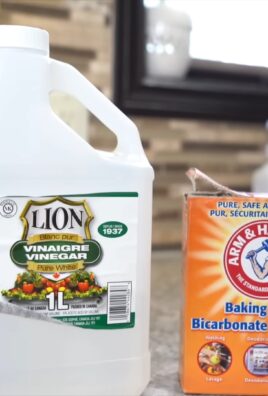Harvesting Zucchini the Right Way can feel like a race against time! One day it’s a cute little blossom, and the next, it’s a potential baseball bat lurking in your garden. I’ve definitely been there, staring in disbelief at a zucchini that seems to have doubled in size overnight. But fear not, fellow gardeners! This isn’t just about picking a vegetable; it’s about maximizing flavor, extending your harvest, and preventing a zucchini overload that leaves you desperately searching for new recipes.
Zucchini, a member of the squash family, has a fascinating history. Originating in the Americas, it wasn’t until Italian immigrants brought it to the United States that it truly gained popularity. Now, it’s a staple in gardens worldwide, prized for its versatility and prolific growth. But that prolific growth is precisely why knowing harvesting zucchini the right way is so crucial.
Why is this DIY trick so important? Well, properly harvested zucchini tastes better, plain and simple. Overgrown zucchini becomes seedy and bland, losing its delicate flavor. Plus, leaving giant zucchinis on the vine actually signals to the plant to stop producing more! By harvesting regularly and at the right size, you encourage continuous fruiting, ensuring a steady supply of delicious zucchini throughout the season. So, let’s dive in and learn the secrets to a bountiful and flavorful zucchini harvest!

Harvesting Zucchini the Right Way: A DIY Guide for Bountiful Squash
Okay, zucchini season is upon us, and if you’re anything like me, you’re probably already drowning in these green beauties! But knowing when and how to harvest them properly is key to enjoying their delicious flavor and keeping your plant producing all summer long. So, let’s dive into my tried-and-true method for harvesting zucchini the right way!
Understanding Zucchini Growth and Maturity
Before we even think about cutting, let’s talk about zucchini growth. These guys are fast growers, and they can go from tiny to enormous in what feels like overnight. The ideal size for harvesting depends on your preference, but generally, smaller zucchini (6-8 inches long) are more tender and flavorful. Larger zucchini can become seedy and less palatable.
Key Indicators of Zucchini Maturity:
* Size: Aim for 6-8 inches for best flavor and texture.
* Skin: The skin should be smooth and firm, not dull or wrinkled.
* Color: A vibrant, consistent green color is a good sign.
* Tenderness: You should be able to easily pierce the skin with your fingernail. If it’s tough, it’s probably past its prime.
Tools You’ll Need
Having the right tools makes the job so much easier and prevents damage to your plant. Here’s what I recommend:
* Sharp Knife or Pruning Shears: A sharp blade is essential for a clean cut. Dull blades can tear the stem and potentially introduce disease.
* Gloves (Optional): Zucchini plants can be a bit prickly, so gloves can protect your hands.
* Basket or Bag: To carry your harvest!
Step-by-Step Harvesting Guide
Alright, let’s get to the fun part! Here’s my step-by-step guide to harvesting zucchini:
1. Identify Mature Zucchini: Walk around your plant and carefully inspect each zucchini. Look for the key indicators of maturity we discussed earlier: size, skin, color, and tenderness. Don’t be afraid to gently handle them to assess their firmness.
2. Prepare Your Cutting Tool: Make sure your knife or pruning shears are clean and sharp. I like to wipe mine down with rubbing alcohol to prevent the spread of any potential diseases.
3. Locate the Stem: Find the stem that connects the zucchini to the main plant. You’ll want to cut the stem about 2-3 inches away from the zucchini itself. This allows for easy handling and prevents damage to the plant.
4. Make the Cut: Using your sharp knife or pruning shears, make a clean, angled cut through the stem. Be careful not to tug or twist the zucchini, as this can damage the plant. A clean cut promotes healthy regrowth.
5. Gently Remove the Zucchini: Once the stem is cut, gently lift the zucchini away from the plant. Avoid pulling or yanking, as this can also damage the plant.
6. Inspect the Plant: After harvesting, take a moment to inspect the plant for any signs of pests or diseases. Early detection is key to preventing problems from spreading.
7. Repeat as Needed: Zucchini plants are prolific producers, so you’ll likely be harvesting regularly throughout the summer. Check your plants every few days and harvest any zucchini that are ready.
Harvesting Different Sizes and Stages
While I generally recommend harvesting zucchini at 6-8 inches, there are times when you might want to harvest them at different sizes.
* Baby Zucchini (3-4 inches): These are incredibly tender and have a delicate flavor. They’re perfect for grilling or adding to salads.
* Large Zucchini (Over 10 inches): While they may not be as tender, large zucchini are still useful. You can shred them for zucchini bread, soups, or stews. Just be sure to remove the seeds first.
Dealing with Overripe Zucchini
Sometimes, despite our best efforts, a zucchini will get away from us and grow too large. Don’t despair! Here’s what you can do with overripe zucchini:
* Shredding: As mentioned earlier, shredding is a great way to use large zucchini. Remove the seeds and grate the flesh. You can then use it in baked goods, soups, or stews.
* Zucchini Boats: Hollow out the zucchini and fill it with a mixture of ground meat, vegetables, and rice. Bake until tender.
* Composting: If the zucchini is truly past its prime, you can compost it. Just be sure to chop it up into smaller pieces first to help it break down faster.
Extending the Harvest Season
Want to keep those zucchini coming all summer long? Here are a few tips for extending the harvest season:
* Regular Harvesting: The more you harvest, the more the plant will produce. Don’t let zucchini get too large, as this can signal to the plant to stop producing.
* Fertilizing: Feed your zucchini plants with a balanced fertilizer every few weeks to provide them with the nutrients they need to keep growing.
* Watering: Zucchini plants need consistent moisture, especially during hot weather. Water deeply and regularly, but avoid overwatering, which can lead to root rot.
* Pest and Disease Control: Keep an eye out for pests and diseases and take action to control them promptly.
Troubleshooting Common Zucchini Problems
Even with the best care, zucchini plants can sometimes encounter problems. Here are a few common issues and how to address them:
* Powdery Mildew: This fungal disease appears as a white, powdery coating on the leaves. To prevent powdery mildew, provide good air circulation around the plants and avoid overhead watering. If you see signs of powdery mildew, you can treat it with a fungicide.
* Squash Vine Borers: These pests can tunnel into the stems of zucchini plants and kill them. To prevent squash vine borers, wrap the base of the stems with aluminum foil or netting. You can also use a biological insecticide.
* Blossom End Rot: This condition causes the ends of the zucchini to rot. It’s usually caused by a calcium deficiency or inconsistent watering. To prevent blossom end rot, amend the soil with calcium before planting and water regularly.
* Lack of Pollination: Sometimes, zucchini plants will produce flowers but no fruit. This is usually due to a lack of pollination. You can hand-pollinate the flowers by transferring pollen from the male flowers to the female flowers.
Storing Your Zucchini Harvest
Once you’ve harvested your zucchini, you’ll want to store it properly to keep it fresh.
* Refrigeration: Store zucchini in the refrigerator in a plastic bag or container. It will typically last for about a week.
* Freezing: You can also freeze zucchini for longer storage. Shred it first and then blanch it in boiling water for a few minutes. Drain and cool the zucchini before freezing it in freezer bags or containers.
* Pickling: Pickled zucchini is a delicious way to preserve your harvest. There are many different pickling recipes available online.
Enjoying Your Zucchini Bounty
Now that you’ve harvested and stored your zucchini, it’s time to enjoy it! There are endless ways to cook with zucchini. Here are a few of my favorites:
* Grilled Zucchini: Slice zucchini lengthwise and grill it until tender. Season with salt, pepper, and your favorite herbs.
* Zucchini Noodles: Use a spiralizer to create zucchini noodles. Sauté them with garlic and olive oil or top them with your favorite sauce.
* Zucchini Bread: This classic recipe is a great way to use up shredded zucchini.
* Zucchini Fritters: Grate zucchini and mix it with flour, eggs, and seasonings. Fry the fritters until golden brown.
* Zucchini Soup: Blend cooked zucchini with broth and seasonings for a creamy and delicious soup.
Conclusion
Harvesting zucchini the right way is essential for enjoying its delicious flavor and keeping your plant producing all summer long. By following these tips, you can ensure a bountiful harvest of tender, flavorful zucchini. Happy gardening!

Conclusion
So, there you have it! Harvesting zucchini the right way isn’t just about grabbing the biggest squash you see. It’s about understanding the plant’s growth cycle, knowing when to pick for optimal flavor and texture, and employing techniques that encourage continued production. This DIY trick – the combination of regular harvesting at the right size, careful cutting to avoid damaging the plant, and consistent monitoring for pests and diseases – is a game-changer for any zucchini enthusiast. It’s a must-try because it directly translates to a more abundant, more flavorful, and ultimately, more satisfying zucchini harvest.
Think of it this way: you’re not just harvesting zucchini; you’re cultivating a relationship with your plant. By understanding its needs and responding accordingly, you’re ensuring a continuous supply of this versatile vegetable throughout the growing season. And trust us, once you taste the difference between a store-bought zucchini and one you’ve lovingly harvested yourself, you’ll never go back.
But the beauty of gardening lies in experimentation! Feel free to adapt this method to your specific needs and preferences. For example, if you’re planning on making zucchini bread, you might prefer to let some of your zucchini grow a bit larger, as the larger size is easier to shred. Just be mindful of the potential for tough skin and seeds. Alternatively, if you’re aiming for delicate zucchini blossoms, harvest the smaller zucchini attached to them when they’re only a few inches long. This will give you both a delicious vegetable and a beautiful edible flower.
Another variation to consider is the timing of your harvest. While harvesting in the morning is generally recommended, you might find that harvesting in the late afternoon works better for you, especially if you live in a particularly hot climate. The key is to experiment and find what works best for your specific growing conditions.
Don’t be afraid to get your hands dirty and try this DIY trick for yourself. We’re confident that you’ll be amazed by the results. And most importantly, we want to hear about your experience! Share your tips, tricks, and zucchini-growing triumphs in the comments below. Let’s build a community of zucchini-loving gardeners who are passionate about harvesting zucchini the right way and maximizing their yields. Happy gardening!
Frequently Asked Questions (FAQs)
Why is the size of the zucchini important when harvesting?
The size of the zucchini is crucial for both flavor and texture. When zucchini grows too large, it tends to become watery, seedy, and less flavorful. The skin also becomes tougher, making it less enjoyable to eat. Harvesting zucchini when it’s between 6-8 inches long ensures that it’s tender, flavorful, and has minimal seeds. This size is also ideal for most culinary applications, from grilling and sautéing to baking and frying. Furthermore, regularly harvesting zucchini at this size encourages the plant to produce more fruit, leading to a more abundant harvest overall.
What’s the best time of day to harvest zucchini?
The best time to harvest zucchini is generally in the morning, before the heat of the day sets in. This is because the zucchini is at its freshest and most hydrated in the morning. The cooler temperatures also help to prevent the zucchini from wilting or becoming damaged during the harvesting process. Harvesting in the morning also gives you the opportunity to inspect your plants for pests and diseases before they have a chance to cause significant damage.
How do I properly cut the zucchini from the plant without damaging it?
Using a sharp knife or pruning shears is essential for properly cutting zucchini from the plant. Avoid pulling or twisting the zucchini, as this can damage the stem and potentially harm the plant. Instead, make a clean, angled cut about 2 inches above the zucchini. This will help to prevent disease from entering the cut stem. Be careful not to cut into the main stem of the plant, as this can also cause damage. A clean cut promotes faster healing and reduces the risk of infection.
What if my zucchini is growing too quickly and I can’t keep up with the harvest?
If your zucchini is growing too quickly, don’t panic! There are several things you can do. First, make sure you’re harvesting regularly, even if you don’t need the zucchini immediately. You can always freeze it for later use. Second, consider succession planting, which involves planting zucchini seeds every few weeks to stagger the harvest. This will help to prevent a glut of zucchini all at once. Finally, you can also try growing different varieties of zucchini, some of which are slower to mature than others.
How do I store harvested zucchini to keep it fresh for longer?
To store harvested zucchini and keep it fresh for longer, wrap it loosely in a paper towel and place it in a plastic bag in the refrigerator. The paper towel will help to absorb excess moisture, which can cause the zucchini to rot. Avoid washing the zucchini before storing it, as this can also promote spoilage. Stored properly, zucchini can last for up to a week in the refrigerator. For longer-term storage, you can freeze zucchini by shredding it, blanching it, and then freezing it in freezer bags.
What are some common pests and diseases that affect zucchini plants, and how can I prevent them?
Common pests that affect zucchini plants include squash bugs, squash vine borers, and aphids. Diseases include powdery mildew and blossom end rot. To prevent these problems, practice good garden hygiene by removing any dead or diseased leaves and debris. Rotate your crops each year to prevent soilborne diseases from building up. Use row covers to protect your plants from pests. Water your plants at the base to avoid wetting the leaves, which can promote fungal diseases. Inspect your plants regularly for signs of pests and diseases, and take action promptly if you notice any problems. Organic pest control methods, such as insecticidal soap and neem oil, can be effective for controlling pests. Ensuring proper soil drainage and providing adequate calcium can help prevent blossom end rot.
Can I eat zucchini blossoms?
Yes, zucchini blossoms are edible and delicious! They can be eaten raw in salads, stuffed with cheese and fried, or used as a garnish. To harvest zucchini blossoms, choose male blossoms (those without a small zucchini attached) or female blossoms with very small zucchini attached. Harvest them in the morning when they are open and fresh. Gently wash the blossoms and remove the stamen (the pollen-bearing part) from the male blossoms.
What are some creative ways to use a large zucchini if I accidentally let it grow too big?
Even if you accidentally let a zucchini grow too large, don’t despair! There are still plenty of ways to use it. Large zucchini are great for making zucchini bread, zucchini muffins, or zucchini fritters. You can also shred it and use it in soups, stews, or sauces. Another option is to hollow out the zucchini and stuff it with meat, vegetables, or rice. Finally, you can compost it to enrich your garden soil.
How does harvesting zucchini the right way impact the overall health and productivity of the plant?
Harvesting zucchini the right way, which includes picking at the optimal size and using proper cutting techniques, significantly impacts the overall health and productivity of the plant. Regular harvesting encourages the plant to continue producing more fruit. Leaving zucchini on the vine for too long signals to the plant that it has completed its reproductive cycle, which can slow down or stop fruit production. Careful cutting prevents damage to the plant, reducing the risk of disease and allowing it to focus its energy on producing more zucchini. By following these guidelines, you can ensure a continuous and abundant harvest throughout the growing season.





Leave a Comment